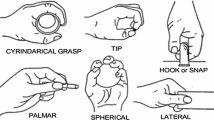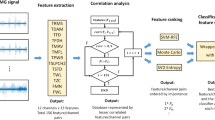Abstract
Electromyography (EMG) is a form of biological information, which is used in many fields to help people study human muscle movement, especially in the study of bionic hands. EMG signals can be used to explain the activity at a certain moment through the signal changes of human muscles, and it is a very complex signal, so processing it is very important. The process of EMG signals can be divided into acquisition, pre-processing, feature extraction, and classification. Not all signal channels are useful in EMG acquisition, and it is important to select useful signals among them. Therefore, this study proposes a feature extraction method to extract the most representative two-channel signals from the eight-channel signals. In this paper, the traditional principal component analysis method and support vector machine feature elimination are used to extract signal channels. At the same time, a new method, correlation heat map, is proposed to implement feature extraction method by using three methods, and three classification algorithms of K-nearest neighbor, random forest, and support vector machine are used to verify. The results show that the classification accuracy of the proposed method is better than that of the other two traditional methods.
Graphical abstract












Similar content being viewed by others
Data availability
The data used to support the findings of this study are included within the article.
References
Furui A, Hayashi H, Tsuji T (2018) An EMG pattern classification method based on a mixture of variance distribution models[C]// 2018 40th Annual International Conference of the IEEE Engineering in Medicine and Biology Society (EMBC). IEEE
Qi J, Jiang G, Li G et al (2020) Surface EMG hand gesture recognition system based on PCA and GRNN[J]. Neural Comput Appl 10:32
Zhang L, Shi Y, Wang W et al (2018) Real-time and user-independent feature classification of forearm using EMG signals[J]. J Soc Inf Disp 27(1/3): 101–107
Long Y, Du Z, Wang W et al (2016) PSO-SVM-based online locomotion mode identification for rehabilitation robotic exoskeletons. Sensors-Basel 16(9):1408
Ameri A, Akhaee MA, Scheme E, Englehart K (2018) Real-time, simultaneous myoelectric control using a convolutional neural network. PLoS One 13(9):e0203835. https://doi.org/10.1371/journal.pone.0203835
She H, Zhu J, Tian Y, Wang Y, Yokoi H, Huang Q (2019) SEMG feature extraction based on stockwell transform improves hand movement recognition accuracy. Sensors 19(20):4457. https://doi.org/10.3390/s19204457
Kendell C, Lemaire ED, Losier Y, Wilson A, Chan A, Hudgins B (2012) A novel approach to surface electromyography: an exploratory study of electrode-pair selection based on signal characteristics. J Neuroeng Rehabil 9(1):24
Nazmi N, Abdul Rahman M, Yamamoto S-I, Ahmad S, Zamzuri H, Mazlan S (2016) A review of classification techniques of EMG signals during isotonic and isometric contractions. Sensors 16(8):1304
Camargo J, Young A (2019) Feature selection and non-linear classifiers: effects on simultaneous motion recognition in upper limb. IEEE Trans Neural Syst Rehabil Eng 27(4):743–750
Krasoulis A, Vijayakumar S, Nazarpour K (2020) Multi-grip classification-based prosthesis control with two EMG-IMU sensors. IEEE Trans Neural Syst Rehabil Eng 28(2):508–518
Adewuyi AA, Hargrove LJ, Kuiken TA (2016) An analysis of intrinsic and extrinsic hand muscle EMG for improved pattern recognition control. IEEE Trans Neural Syst Rehabil Eng 24(4):485–494
Veer K, Sharma T (2016) A novel feature extraction for robust EMG pattern recognition. J Med Eng Technol 40:149–154
Meng Q, Zhang J, Yang X (2019) Virtual rehabilitation training system based on surface EMG feature extraction and analysis. J Med Syst 43:48. https://doi.org/10.1007/s10916-019-1166-z
Wu SA (2015) Traffic motion object extraction algorithm. Int J Bifurcat Chaos 25(14):1540039
Veer K, Agarwal R (2015) Wavelet and short-time Fourier transform comparison-based analysis of myoelectric signals. J Appl Stat 42:1591–1601
Englehart K, Hudgins B (2003) A robust, real-time control scheme for multifunction myoelectric control. IEEE Trans Biomed Eng 50:848–854
Li D, Pedrycz W, Pizzi NJ (2005) Fuzzy wavelet packet based feature extraction method and its application to biomedical signal classification. IEEE Trans Biomed Eng 52:1132–1139
Shahzaib M, Shakil S, Ghuffar S et al (2021) Classification of forearm EMG signals for 10 motions using optimum feature-channel combinations[J]. Comput Methods Biomech Biomed Engin 24(9):945–955
Lobov S, Krilova N, Kastalskiy I, Kazantsev V, Makarov VA (2018) Latent factors limiting the performance of sEMG-interfaces. Sensors 18:1122
Saikia A, Mazumdar S, Sahai N et al (2022) Performance analysis of artificial neural network for hand movement detection from EMG signals[J]. IETE J Res 68(2):1074–1083. https://doi.org/10.1080/03772063.2019.1638316
Guyon I, Weston J, Barnhill S et al (2002) Gene selection for cancer classification using support vector machines[J]. Mach Learn 46(1–3):389–422
Zhou Z (2016) Machine learning[M]. Tsinghua University Press, Beijing, p 133–140
Huang X, Zhang L (2015) Improved multi-class support vector machine recursive feature elimination in cancer multi-classification [J]. Comput Appl
Ahmed M, Elbeshbeshy, Muhammad A, Rushdi and Shereen M. El-Metwally (2021) Electromyography signal analysis and classification using timefrequency representations and deep learning. 2021 43rd Annual International Conference of the IEEE Engineering in Medicine & Biology Society (EMBC), p 661–664
Cover TM, Hart PE (1967) Nearest neighbor pattern classification. IEEE Trans Inf Theory
Huxin T (2016) Website operation and data analysis two-color edition. Aviation Industry Press, p 81–82
Qinlong H, Yixian Y (2018) Cloud computing data security, Beijing: Beijing University of Posts and Telecommunications Press, p 95
Breiman L (2001) Random forest[J]. Mach Learn 45:5–32
Vapnik VN, Lerner AY (1963) Recognition of patterns with help of generalized portraits. Avtomat i Telemekh 24(6):774–780
Vapnik V (1998) Statistical learning theory, Chapter 10–11, Vol. 3. Wiley, New York, pp 401–492
Zhou Z (2016) Machine learning[M]. Tsinghua University Press, Beijing, pp 121–139, 298–300
Hang L (2012) Statistical learning methods, Chapter 7. Tsinghua University Press, Beijing, pp 95–135
Author information
Authors and Affiliations
Corresponding author
Ethics declarations
Conflict of interest
The authors declare that they do not have any conflict of interest.
Additional information
Publisher's note
Springer Nature remains neutral with regard to jurisdictional claims in published maps and institutional affiliations.
Rights and permissions
Springer Nature or its licensor (e.g. a society or other partner) holds exclusive rights to this article under a publishing agreement with the author(s) or other rightsholder(s); author self-archiving of the accepted manuscript version of this article is solely governed by the terms of such publishing agreement and applicable law.
About this article
Cite this article
Zhang, X., Zhang, M. Study on the methods of feature extraction based on electromyographic signal classification. Med Biol Eng Comput 61, 1773–1781 (2023). https://doi.org/10.1007/s11517-023-02812-3
Received:
Accepted:
Published:
Issue Date:
DOI: https://doi.org/10.1007/s11517-023-02812-3




